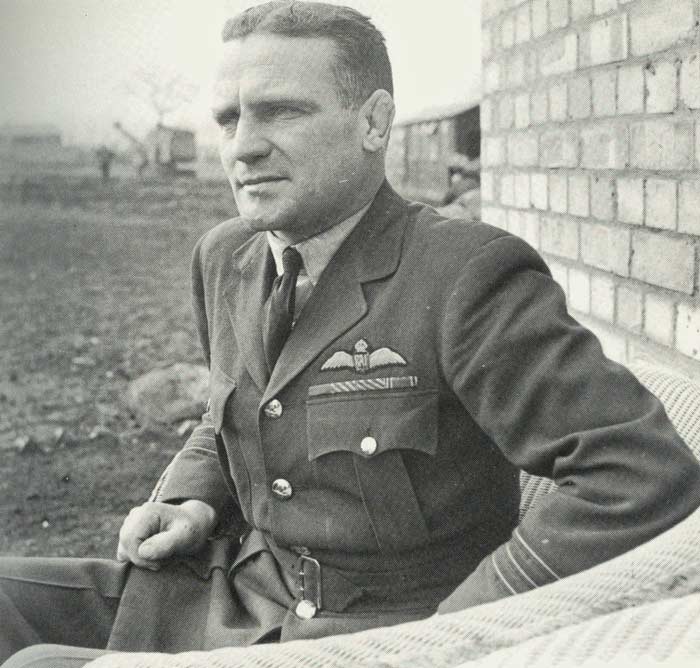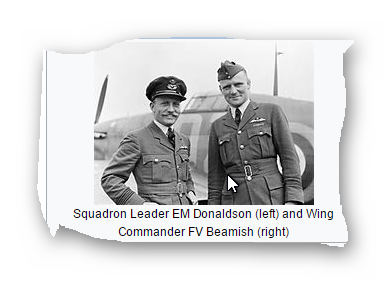BEAMISH, Francis Victor
Stats:
rank: G/Cstatus: kia
airforce: RAF (no: 16089 )
born: 1903-09-23 Dunmanway Ireland
added by: --
Bio / Text:
This pilot flew fighter aircraft for the RAF in WWII, this record has come from the RAF Archives with a log book reference. The log book is available for viewing in the RAF London archives. The data we parsed includes pilot name, rank, awards, and log book dates - but little else, i.e. country of birth or aircraft flown. We have made country of birth the UK until users edit the pilot listing to make a correction, figuring a majority will be UK pilots. We do have a reference number for the operational log book(s) available in the RAF archives, in London, and the reference numbers include: Log Book accession no. AC94/36/2. If a user conducts research on this pilot and can fill in this pilot's biography further by clicking edit, or, can visit the RAF archives to inspect the log book(s) and add any aircraft serials or sortie details, this change will be reflected in your profile as recognition. Let us know if you visit the archives.
Added by Red Dragon
Francis Victor Beamish was born at Dunmanway, County Cork in the Irish Republic on 27th September 1903. He attended the Coleraine Academical Institute and then entered the RAF College, Cranwell as a Flight Cadet on 14th September 1921. After graduation in August 1923 he went to 4 (Army Co-operation) Squadron at Farnborough on 18th September that year. In January 1925 he was posted to the School of Army Co-operation at Old Sarum.
Beamish went overseas later in the year and joined 31 Squadron at Ambala on 18th November but stayed only four months before moving to 60 Squadron at Kohat. He was back in the UK in October 1926 for a course at the Central Flying School, Wittering. With this completed he went to 5 FTS Sealand as an instructor.
On 16th September 1927 Beamish went back to Cranwell, this time on the staff. He went to Canada on 22nd March 1929 on exchange with an RCAF officer. When he returned two years later he was posted to 25 Squadron at Hawkinge as a Flight Commander.
In January 1932 Beamish was appointed Personal Assistant to the AOC at Uxbridge. A year later he went into hospital at Uxbridge, suffering from tuberculosis, with the result that he had to retire from the RAF on 18th October 1933.
Very unhappy at this, Beamish got a job as civilian assistant at 2 FTS Digby, later returning to Ireland in 1936 to become civilian adjutant at RAF Aldergrove on 18th May. This was a non-flying appointment in the Air Force Reserve. Beamish was sufficiently recovered to be reinstated with full flying status as a Flight Lieutenant on 27th January 1937 and was posted to command 2 Armament Training Camp and Met Flight at Aldergrove. His comeback was complete when he was given command of 64 Squadron at Church Fenton on 8th December 1937. He was awarded the AFC (gazetted 1st January 1938) for establishing the Met Flight.
AFC Citation
For his work in the formation of the "Met Flight"
DSO Citation
Wing Commander Beamish took over command of a Royal Air Force station after two squadrons there had been intensively engaged in successful fighting operations over France for thirteen days and personally led them on many patrols against the enemy. In June, 1940, during an offensive mission over France, six Messerschmitt Bf 109s were destroyed, two of them by Wing Commander Beamish himself and twelve driven off. One day recently he assisted in the destruction of a Messerschmitt Bf 110 whilst leading the escort to a convoy and three days later he shot down a Dornier Do 17. This officer's outstanding leadership and high courage have inspired all those under his command with great energy and dash.
DFC citation
The work of this station commander has been outstanding. He has displayed exceptional keenness in his engagements against the enemy and has recently destroyed one and possibly a further seven enemy aircraft. His coolness and courage have proved an inspiration to all.
Bar to DSO Citation
Group Captain Beamish commanded a Royal Air Force Station from October 1940 to March, 1941 and during that period carried out 71 operational sorties in which he destroyed an enemy fighter, probably destroyed three other hostile aircraft and damaged others. Since his appointment to Group headquarters he has taken part in further sorties and has probably destroyed two more enemy aircraft. The courage and devotion to duty displayed by Group Captain Beamish are of the highest order and he has set a magnificent example.
After a course at RAF Staff College, Andover, he took command of 504 Squadron at Digby on 13th September 1939. He returned to Canada in mid-January 1940 on Air Staff duties but, back in the UK, he took over RAF North Weald on 7th June 1940. Beamish flew operational sorties with his station squadrons whenever he could.
On 18th June he claimed two Me109’s destroyed, on 9th July a Me110 damaged, on the 12th a Do17 shot down, on 18th August a probable Ju88, on the 24th a Do17 damaged and on the 30th two probable Me110’s. On 6th September Beamish claimed two Ju87’s, on the 11th a probable He111, on the 15th a share in a He111 and on the 18th and 27th probable Me109’s. He damaged a Me109 on 12th October, probably destroyed one and damaged another on the 25th and probably shot down another on the 30th.
Beamish was awarded the DSO (gazetted 23rd July 1940) and the DFC (gazetted 8th November 1940).
On 7th November 1940 Beamish collided with P/O TF Neil of 249 Squadron whilst on patrol and made a forced-landing at Leeds Castle in Kent. In all his sorties in 1940, he was damaged by enemy action three times, on each occasion getting his aircraft down safely.
On 11th November 1940, Italian aircraft based in Belgium attempted a raid and Beamish claimed a probable CR42 biplane fighter. Two days later he damaged a Me109 near Dover. On 10th January 1941 he shot down a Me109 over the Channel. Beamish was posted to HQ 11 Group on 17th March 1941. He was back in action later that year and claimed a probable Me109 near Mardyck on 9th August 1941. He was awarded a Bar to the DSO (gazetted 25th September 1941).
On 25th January 1942 Beamish went to RAF Kenley to take command and again flew with his squadrons. With W/Cdr. RF Boyd he took off on the morning of 12th February 'to see what was happening on the other side'. After chasing two Me109’s, they saw part of the German Fleet making its 'Channel Dash'. The ships had been reported ten minutes earlier by two pilots of 91 Squadron but the news was received with complete disbelief at 11 Group. Beamish's confirmation was enough to set in motion a series of uncoordinated attacks on the German fleet.
On 13th February Beamish had a share in the destruction of a He115 over the Channel. On 9th March he claimed a Fw190 destroyed and another on the 26th, as well as a Me109. Leading the Kenley Wing and flying in Spitfire W3649/FV-B with 485 (NZ) Squadron on 28th March, Beamish saw a force of Me109’s and Fw190’s a few miles south of Calais. He turned the Wing towards them. In the ensuing engagement Beamish was seen to be attacked and damaged by a Me109. He requested a vector over the radio and was last seen entering a cloud near Calais. It is presumed that he crashed into the Channel, possibly wounded and perhaps unconscious. He was 38 years old.
Victor Beamish was one of a small band of near-legendary figures in the RAF. He was photographed by Cecil Beaton and had his portrait made by both Cuthbert Orde and Eric Kennington
He is remembered at Runnymede Memorial Panel 64.
Son of Francis George Beamish, and of Mary Elizabeth Beamish, of Castlerock, Co. Derry.
Ref
CWGC
Battle of Britain Monument
Find A Grave
Added by Red Dragon
Francis Victor Beamish was born at Dunmanway, County Cork in the Irish Republic on 27th September 1903. He attended the Coleraine Academical Institute and then entered the RAF College, Cranwell as a Flight Cadet on 14th September 1921. After graduation in August 1923 he went to 4 (Army Co-operation) Squadron at Farnborough on 18th September that year. In January 1925 he was posted to the School of Army Co-operation at Old Sarum.
Beamish went overseas later in the year and joined 31 Squadron at Ambala on 18th November but stayed only four months before moving to 60 Squadron at Kohat. He was back in the UK in October 1926 for a course at the Central Flying School, Wittering. With this completed he went to 5 FTS Sealand as an instructor.
On 16th September 1927 Beamish went back to Cranwell, this time on the staff. He went to Canada on 22nd March 1929 on exchange with an RCAF officer. When he returned two years later he was posted to 25 Squadron at Hawkinge as a Flight Commander.
In January 1932 Beamish was appointed Personal Assistant to the AOC at Uxbridge. A year later he went into hospital at Uxbridge, suffering from tuberculosis, with the result that he had to retire from the RAF on 18th October 1933.
Very unhappy at this, Beamish got a job as civilian assistant at 2 FTS Digby, later returning to Ireland in 1936 to become civilian adjutant at RAF Aldergrove on 18th May. This was a non-flying appointment in the Air Force Reserve. Beamish was sufficiently recovered to be reinstated with full flying status as a Flight Lieutenant on 27th January 1937 and was posted to command 2 Armament Training Camp and Met Flight at Aldergrove. His comeback was complete when he was given command of 64 Squadron at Church Fenton on 8th December 1937. He was awarded the AFC (gazetted 1st January 1938) for establishing the Met Flight.
AFC Citation
For his work in the formation of the "Met Flight"
DSO Citation
Wing Commander Beamish took over command of a Royal Air Force station after two squadrons there had been intensively engaged in successful fighting operations over France for thirteen days and personally led them on many patrols against the enemy. In June, 1940, during an offensive mission over France, six Messerschmitt Bf 109s were destroyed, two of them by Wing Commander Beamish himself and twelve driven off. One day recently he assisted in the destruction of a Messerschmitt Bf 110 whilst leading the escort to a convoy and three days later he shot down a Dornier Do 17. This officer's outstanding leadership and high courage have inspired all those under his command with great energy and dash.
DFC citation
The work of this station commander has been outstanding. He has displayed exceptional keenness in his engagements against the enemy and has recently destroyed one and possibly a further seven enemy aircraft. His coolness and courage have proved an inspiration to all.
Bar to DSO Citation
Group Captain Beamish commanded a Royal Air Force Station from October 1940 to March, 1941 and during that period carried out 71 operational sorties in which he destroyed an enemy fighter, probably destroyed three other hostile aircraft and damaged others. Since his appointment to Group headquarters he has taken part in further sorties and has probably destroyed two more enemy aircraft. The courage and devotion to duty displayed by Group Captain Beamish are of the highest order and he has set a magnificent example.
After a course at RAF Staff College, Andover, he took command of 504 Squadron at Digby on 13th September 1939. He returned to Canada in mid-January 1940 on Air Staff duties but, back in the UK, he took over RAF North Weald on 7th June 1940. Beamish flew operational sorties with his station squadrons whenever he could.
On 18th June he claimed two Me109’s destroyed, on 9th July a Me110 damaged, on the 12th a Do17 shot down, on 18th August a probable Ju88, on the 24th a Do17 damaged and on the 30th two probable Me110’s. On 6th September Beamish claimed two Ju87’s, on the 11th a probable He111, on the 15th a share in a He111 and on the 18th and 27th probable Me109’s. He damaged a Me109 on 12th October, probably destroyed one and damaged another on the 25th and probably shot down another on the 30th.
Beamish was awarded the DSO (gazetted 23rd July 1940) and the DFC (gazetted 8th November 1940).
On 7th November 1940 Beamish collided with P/O TF Neil of 249 Squadron whilst on patrol and made a forced-landing at Leeds Castle in Kent. In all his sorties in 1940, he was damaged by enemy action three times, on each occasion getting his aircraft down safely.
On 11th November 1940, Italian aircraft based in Belgium attempted a raid and Beamish claimed a probable CR42 biplane fighter. Two days later he damaged a Me109 near Dover. On 10th January 1941 he shot down a Me109 over the Channel. Beamish was posted to HQ 11 Group on 17th March 1941. He was back in action later that year and claimed a probable Me109 near Mardyck on 9th August 1941. He was awarded a Bar to the DSO (gazetted 25th September 1941).
On 25th January 1942 Beamish went to RAF Kenley to take command and again flew with his squadrons. With W/Cdr. RF Boyd he took off on the morning of 12th February 'to see what was happening on the other side'. After chasing two Me109’s, they saw part of the German Fleet making its 'Channel Dash'. The ships had been reported ten minutes earlier by two pilots of 91 Squadron but the news was received with complete disbelief at 11 Group. Beamish's confirmation was enough to set in motion a series of uncoordinated attacks on the German fleet.
On 13th February Beamish had a share in the destruction of a He115 over the Channel. On 9th March he claimed a Fw190 destroyed and another on the 26th, as well as a Me109. Leading the Kenley Wing and flying in Spitfire W3649/FV-B with 485 (NZ) Squadron on 28th March, Beamish saw a force of Me109’s and Fw190’s a few miles south of Calais. He turned the Wing towards them. In the ensuing engagement Beamish was seen to be attacked and damaged by a Me109. He requested a vector over the radio and was last seen entering a cloud near Calais. It is presumed that he crashed into the Channel, possibly wounded and perhaps unconscious. He was 38 years old.
Victor Beamish was one of a small band of near-legendary figures in the RAF. He was photographed by Cecil Beaton and had his portrait made by both Cuthbert Orde and Eric Kennington
He is remembered at Runnymede Memorial Panel 64.
Son of Francis George Beamish, and of Mary Elizabeth Beamish, of Castlerock, Co. Derry.
Ref
CWGC
Battle of Britain Monument
Find A Grave
Squadrons:
| Squadrons add | |||
|---|---|---|---|
| Airforce | Sqdrn | Start | Finish |
| none provided | |||
Aircraft:
| Aircraftadd | ||
|---|---|---|
| Serial | Note | Date |
| W3649 | FV-B | 1942-03-28 |
post
Comments / Questions:
post





